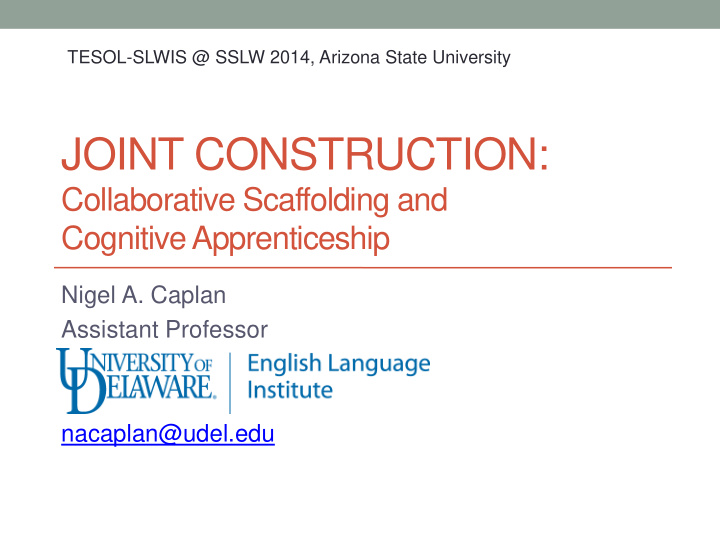



TESOL-SLWIS @ SSLW 2014, Arizona State University JOINT CONSTRUCTION: Collaborative Scaffolding and Cognitive Apprenticeship Nigel A. Caplan Assistant Professor nacaplan@udel.edu
Teaching/Learning Cycle Joint Construction is “ the most powerful classroom practice currently available as far as learning written genres is concerned” (Rose & Martin, 2012, p. 73) Martin, 2009; Rothery, 1999
Joint Construction Tasks • Teacher-led whole class writing • Group or pair collaborative writing • Group/class text completing • Group/class text editing • Comparison with a model (and rewriting) • Role play of the text in groups • Information gap to construct a text (adapted from Feez, 1988, p. 128)
Theoretical Frameworks • Sociocultural • “ Guidance through interaction in the context of shared experience” (Martin, 2009) • Cognitive • Self-Regulated Strategy Development (Harris & Graham, 1996) • Cognitive writing processes (Hayes & Flower, 1980; MacArthur, 2011) • SLA: Languaging (Swain, 2006)
What happens during JC? • Collaborative scaffolding (Donato, 2004) • Cognitive apprenticeship (Daiute & Dalton, 1986) • Negotiation and languaging (Pica, 1994; Swain, 2006) (Dreyfus, Humphrey, & Macnaught, 2011; Storch, 2002; Swain & Lapkin, 2002; Watanabe & Swain, 2007)
• T: Can someone put that into a sentence for us? • S: Regular soda growth correspond with the whole consumption. • T : OK. It’s not actually growth, though.. Maybe negative growth, but we could call it something else. • S: decline? • T: Yes. Corresponds with? I’m going to give you a word here , the word is accounts for. Let me show you how you might use that. [Re-reads the whole paragraph so far] I’m re -reading the sentence so I remember what we said and I can explain it next. However, what has happened? however? Since then. Since then sales of regular soda – • S; begin to decline • T: have begun to decline. Sharply? • S: gradually • T: gradually. Very nice. Or I would move that: have gradually begun to decline. There is a tendency to put the adverb in between the main verb. • S: What is gradually? • T: What is gradually? • S: slowly • T: Slowly, a little bit at a time . That’s a good question. You could say slowly? • S: Smoothly • T: Smoothly? …. It is a smooth decline. [types "However,"] However… So what are we going to talk about next? • S: Diet • T: Diet sodas, very good. What has happened to sales of diet sodas? Author’s unpublished data
What could be the results of JC? • Strategic knowledge • Genre knowledge • Content knowledge • Writing and L2 development (O’Donnell et al., 1985; Storch, 2013; Louth et al., 1993; Bacha, 2010; Shehadeh, 2011)
That’s a really good data commentary. Are you happy with this? Is there anything else you desperately want to change? S: Can we say for a period … when you write from 1970 to 1980 and then you analyze it, and then maybe you come up with something and analyze it. T: Yes, OK, what you could have done is say, OK between 1950 and 1980, there was one pattern. Since 1980 the pattern has changed. So absolutely you could analyze one pattern first and then say after that there was a difference pattern. Absolutely, that could be very interesting. S: In conclusion there are two sentences. So it’s OK to just write two sentence? T: Yep, your conclusion can be fairly short. S: I have a question. How to use numbers which are showing in graph? I know the author use the numbers to demonstrate his or her research, but in our summarize, how to use these numbers, how to distinguish which numbers is the most important? T: That’s a great question, how do we choose which numbers are most important to include in the data commentary? Does anyone have any thoughts about that? S: I think the low number and the high number. T: Yep. So look for the greatest contrast. S: The big gap between numbers. T: Look for the big gaps. Mhm. Author’s unpublished data
Implications for Teaching • Try it! • Choose a short text • Build field • Scaffold from an expert role • Think aloud • Repeat
Implications for Research • Process and product research • Mixed methods approaches
TESOL-SLWIS @ SSLW 2014, Arizona State University JOINT CONSTRUCTION: Collaborative Scaffolding and Cognitive Apprenticeship Nigel A. Caplan nacaplan@udel.edu http://nigelteacher.wordpress.com/sslw2014
Recommend
More recommend